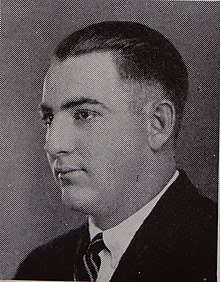 Blott from 1925 Michiganensian | |
| Biographical details | |
|---|---|
| Born | August 24, 1902 Girard, Ohio, U.S. |
| Died | June 11, 1964 (aged 61) Ann Arbor, Michigan, U.S. |
| Alma mater | Michigan |
| Playing career | |
| 1922–1923 | Michigan Wolverines |
| Position(s) | C/K |
| Coaching career (HC unless noted) | |
| 1924–1933 | Michigan (Football-Asst.) |
| 1934–1940 | Wesleyan (Football/Baseball) |
| 1946–1958 | Michigan (Football-OL) |
| Head coaching record | |
| Overall | 31–24–1 (football) |
| Accomplishments and honors | |
| Championships | |
| Awards | |
| |
- ↑ "Ernie Vick Is Succeeded By Jack Blott". Oakland Tribune. November 12, 1922.
- ↑ "University of Michigan 1922 Football Team". The Regents of the University of Michigan. Retrieved December 16, 2007.
- ↑ "University of Michigan 1923 Football Team". The Regents of the University of Michigan. Retrieved December 16, 2007.
- ↑ "Michigan Victor in Badger Game By Use of Head". Capital Times (Madison, Wisc.). October 8, 1923.
- ↑ "Michigan Squad Not Ready as Game Looms". Capital Times (Madison, Wisc.). October 8, 1923.
- ↑ "Michigan-Vanderbilt". The Lima News. December 18, 1923.
- ↑ "Center Scores Touchdown in Most Unusual Manner". The Ogden Standard-Examiner. November 26, 1923.
- ↑ Kipke, Harry (October 7, 1934). "Lauds Officials for Rulings in Football". The Tyrone (Penn.) Daily Herald.
- ↑ "Hot Off the Grid". Logansport Pharos-Tribune. November 19, 1923.
- ↑ "Blott Is Twelfth Yostman to Get Place on Camp's All-American: He's Also the Fourth Michigan Center Slated for Mythical Team". The News-Palladium (Benton Harbor, Michigan). December 18, 1923.
- ↑ "Three Westerners On Camp's All-American Team". The Capital Times (Madison, Wisconsin). December 18, 1923.
- ↑ "Five Stars on Yost's Eleven: Kipke, Steger, Blott, Muirhead and Uteritz Among Best in Big Ten". Iowa City Press-Citizen. November 6, 1923.
- 1 2 "Jack Blott Is Most Versatile Center In Game". The Bismarck Tribune. October 14, 1923.
- ↑ "Michigan Names Two". Iowa City Press-Citizen. June 5, 1923.
- ↑ "Michigan Baseball Captains". The Regents of the University of Michigan. Retrieved December 16, 2007.[ permanent dead link ]
- 1 2 3 "Major Leagues Calling Blott: Cards, Yanks, and Reds Make Offer to Michigan's Great Athlete". Iowa City Press-Citizen. June 6, 1924.
- ↑ "Jack Blott Hits Two Homers in Final Game". Daily Globe (Ironwood, Michigan). April 22, 1924.
- 1 2 "Jack Blott to Reds". San Antonio Express. June 16, 1924.
- ↑ "N.Y. Yankees and Cards After U. of M. Captain and Catcher". Daily Kennebec Journal (Maine). April 11, 1924.
- 1 2 "Signs With Reds". Nebraska State Journal. June 20, 1924.
- ↑ Perry, Lawrence (June 27, 1924). "Jack Blott, Sought by Stars but Landed by Cincinnati, Stands Out as Best Catcher in Years". Syracuse Herald.
- ↑ "Jack Blott". Baseball-Reference.com. Retrieved December 16, 2007.
- 1 2 "Gridiron Stars Fizzle in Big League Baseball". Iowa City Press-Citizen. October 27, 1924.
- ↑ "Cincinnati Reds Mystery Team as Hot Stuff Develops: Club May Become Strong Contender for 1925 Pennantl". The Port Arthur News. December 31, 1924.
- 1 2 3 "Billy Evans Says". The Lima News. December 7, 1924.
- ↑ "Billy Evans Says". Wisconsin Rapids Daily Tribune. February 7, 1924.
- ↑ "Reds Lose Blott; Will Assist Yost". San Antonio Light. February 12, 1925.
- ↑ "Billy Evans Says". Wisconsin Rapids Daily Tribune. February 17, 1925.
- ↑ "With the Reds at Orlando". Zanesville Time Signal. March 15, 1925.
- ↑ "Blott Is Added to Coach Staff at Michigan U.". September 1924.
- ↑ "Michigan Holds to Coaching Staff". Reno Evening Gazette. January 30, 1934.
- ↑ "Oosterbaan and Blott to Quit Michigan for Yale Staff". Syracuse Herald. January 26, 1934.
- ↑ "Says Wolves' Staff Intact: Yost Confident Coaches Will Remain". Evening Independent (Masillon, Ohio). January 30, 1934.
- ↑ "Jack Blott Still Pondering Coaching Job at Wesleyan". The News Palladium (Benton Harbor, Michigan). February 8, 1934.
- ↑ "Need Yost's Approval to Clinch Line Coach Position for Bernard: Local Athlete Expected to Replace Jack Blott". The News Palladium (Benton Harbor, Michigan). February 27, 1934.
- ↑ "Wesleyan University Football History". Wesleyan University. Archived from the original on September 11, 2006. Retrieved December 16, 2007.
- ↑ Feder, Sid (January 31, 1938). "Around the Circuit". Kingsport Times (Tenn.).
- ↑ "Casualty List of Coaches Out". The News (Frederick, Maryland). December 31, 1937.
- ↑ "Wes Fesler Named Coach at Wesleyan". San Antonio Light. December 6, 1940.
- 1 2 "Michigan Line Will Be Coached by Jack Blott". The Port Arthur News. February 24, 1946.
- ↑ "Contract with Ford Asked by UAW-CIO Union". Circleville, Herald (Ohio). June 2, 1941.
- ↑ "Blott on his Escutcheon". The Gettysburg Times. May 10, 1949.
- ↑ "Accent on Youth in UM Staff". The News Palladium (Benton Harbor, Mich.). December 26, 1958.
- 1 2 3 "Jack Blott, Line Coach At Michigan and 1923 All-American, Dies". Appleton Post-Crescent. June 13, 1964.
- ↑ "University of Michigan Hall of Honor". The Regents of the University of Michigan. Archived from the original on October 27, 2007. Retrieved December 16, 2007.
- ↑ Butzback, O.K. "Sigma Man Heads Publication" Purple Green and Gold. June 1924.
External links
| Jack Blott | |
|---|---|
| Catcher | |
Batted: Right Threw: Right | |
| MLB debut | |
| July 30, 1924, for the Cincinnati Reds | |
| Last MLB appearance | |
| September 3, 1924, for the Cincinnati Reds |
|















